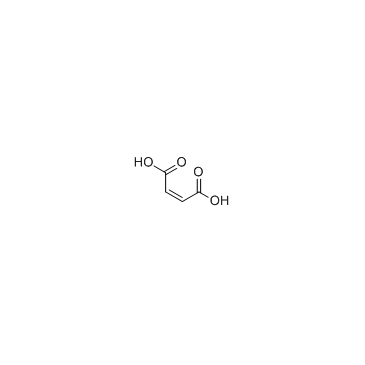| Description |
Rosiglitazone maleate is a potent and selective activator of PPARγ, with EC50s of 30 nM, 100 nM and 60 nM for PPARγ1, PPARγ2, and PPARγ, respectively, and a Kd of appr 40 nM for PPARγ; Rosiglitazone maleate is also an modulator of TRP channels, inhibits TRP melastatin 2 (TRPM2), TRPM3 and activates TRP canonical 5 (TRPC5).
|
| Related Catalog |
|
| Target |
PPARγ1:30 nM (EC50)
PPARγ2:100 nM (EC50)
|
| In Vitro |
Rosiglitazone maleate is a potent and selective activator of PPARγ, with EC50s of 30 nM and 100 nM for PPARγ1 and PPARγ2, respectively, and a Kd of appr 40 nM for PPARγ. Rosiglitazone (BRL49653, 0.1, 1,10 μM) promotes differentiation of C3H10T1/2 stem cells to adipocytes[1]. Rosiglitazone (Compound 6) activates PPARγ, with an EC50 of 60 nM[2]. Rosiglitazone (1 μM) activates PPARγ, which binds to NF-α1 promoter to activate gene transcription in neurons. Rosiglitazone (1 μM) also protects Neuro2A cells and hippocampal neurons against oxidative stress, and up-regulates BCL-2 expression in an NF-α1-dependent manner[3]. Rosiglitazone completely inhibits TRPM3 with IC50 values of 9.5 and 4.6 μM against nifedipine- and PregS-evoked activity, but such effects are not via PPARγ. Rosiglitazone inhibits TRPM2 at higher concentration, with an IC50 of appr 22.5 μM. Rosiglitazone is a strong stimulator of TRPC5 channels, with an EC50 of ∼30 μM[4].
|
| In Vivo |
Rosiglitazone (5 mg/kg, p.o.) decreases the serum glucose in diabetic rats. Rosiglitazone also decreases IL-6, TNF-α, and VCAM-1 levels in diabetic group. Rosiglitazone in combination with losartan increases glucose compared to diabetic and Los-treated groups. Rosiglitazone significantly ameliorates endothelial dysfunction indicated by a significantly lower contractile response to PE and Ang II and enhancement of ACh-provoked relaxation in aortas isolated from diabetic rats[5].
|
| Kinase Assay |
cDNA encoding amino acids 174-475 of PPARγ1 is amplified via polymerase chain reaction and inserted into bacterial expression vector pGEX-2T. GST-PPARγ LBD is expressed in BL21(DE3)plysS cells and extracts. For saturation binding analysis, bacterial extracts (100 μg of protein) are incubated at 4°C for 3 h in buffer containing 10 mM Tris (pH 8.0), 50 mM KCl, 10 mM dithiothreitol with [3H]-BRL49653 (specific activity, 40 Ci/mmol) in the presence or absence of unlabeled Rosiglitazone. Bound is separated from free radioactivity by elution through 1-mL Sephadex G-25 desalting columns. Bound radioactivity eluted in the column void volume and is quantitated by liquid scintillation counting[1].
|
| Cell Assay |
C3H10T1/2 cells are grown in a 24-well plate in DME medium supplemented with 10% fetal calf serum. Medium and compound (Rosiglitazone) are exchanged every 3 days. Cells are stained at day 7 with Oil Red O and photographed[1].
|
| Animal Admin |
Rats are intravenously injected with 38 mg/kg streptozotocin and after 48 h, diabetes is identified by urinary glucosuria and then random blood sugar is measured and this day is regarded as day 0. Animals with a serum glucose level of 220-300 mg/dL are selected to be used in this study. Rats are randomly separated into five groups for daily drug administration for 8 weeks: group 1: control nondiabetic rats given a vehicle only (0.5 mL/kg of 0.5% carboxy methyl celleluse orally), group 2: control diabetic rats given a vehicle, group 3: diabetic rats receiving Rosiglitazone (5 mg/kg orally), group 4: diabetic rats receiving losartan (2 mg/kg, orally), and group 5: diabetic rats receiving both Rosiglitazone and losartan[2].
|
| References |
[1]. Lehmann JM, et al. An antidiabetic thiazolidinedione is a high affinity ligand for peroxisome proliferator-activated receptor gamma (PPAR gamma). J Biol Chem. 1995 Jun 2;270(22):12953-6. [2]. Willson TM, et al. The structure-activity relationship between peroxisome proliferator-activated receptor gamma agonism and the antihyperglycemic activity of thiazolidinediones. J Med Chem. 1996 Feb 2;39(3):665-8. [3]. Thouennon E, et al. Rosiglitazone-activated PPARγ induces neurotrophic factor-α1 transcription contributing to neuroprotection. J Neurochem. 2015 Aug;134(3):463-70. [4]. Majeed Y, et al. Rapid and contrasting effects of rosiglitazone on transient receptor potential TRPM3 and TRPC5 channels. Mol Pharmacol. 2011 Jun;79(6):1023-30. [5]. Ateyya H, et al. Beneficial effects of rosiglitazone and losartan combination in diabetic rats. Can J Physiol Pharmacol. 2018 Mar;96(3):215-220.
|





